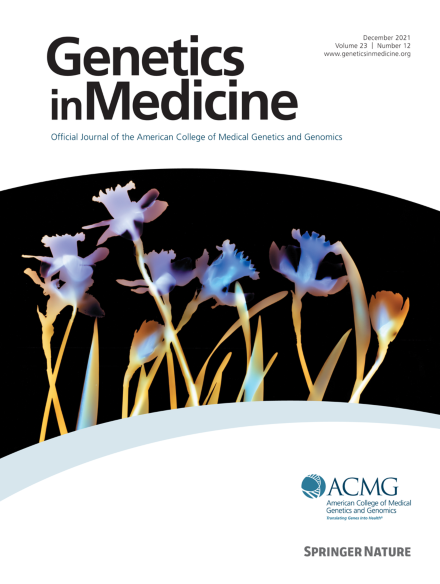Deep phenotyping of 11 individuals with pathogenic variants in RNU4-2 reveals a clinically recognizable syndrome
IF 6.2
1区 医学
Q1 GENETICS & HEREDITY
引用次数: 0
Abstract
Purpose
Despite ever-increasing knowledge of the genetic etiologies of neurodevelopmental disorders, approximately half remain undiagnosed after exome or genome sequencing. Here, we provide a deep clinical characterization of 11 previously unreported patients with a recently described neurodevelopmental disorder (NDD) due to pathogenic variants in RNU4-2.
Methods
The 11 patients were identified in a pool of 70 patients selected for targeted RNU4-2 sequencing on the basis of their clinical phenotypes from a cohort of 1032 individuals with a NDD and without a prior genetic diagnosis.
Results
The 11 patients were aged between 13 months and 36 years. All patients showed moderate to severe developmental delay and/or intellectual disability. Height and weight were below 10th percentile and most showed microcephaly. In almost 50% of the patients, intrauterine growth retardation was detected. All patients showed a distinctive pattern of dysmorphic features, including hooded upper eyelid and epicanthus, full cheeks, tented philtrum, mouth constantly slightly open with an everted lower lip vermilion, high palate, and profuse drooling. Of 11 patients, 64% also presented with ophthalmological problems (mainly strabismus, nystagmus, and refraction errors) and 64% had musculoskeletal features (joint hypermobility, mild scoliosis, and easy fractures).
Conclusion
This work provides an improved characterization of the phenotypic spectrum of RNU4-2 syndrome across different age groups and demonstrates that thorough clinical assessment of patients with an NDD can be enhanced significantly for this novel syndrome.
对 11 个具有 RNU4-2 致病变体的个体进行深度表型分析,发现了一种临床上可识别的综合征。
目的:尽管人们对神经发育障碍遗传病因的了解不断增加,但在进行外显子组或基因组测序后,仍有约一半的患者未被确诊。在此,我们对 11 名以前未报道过的患者进行了深入的临床特征描述,这些患者最近被描述为神经发育障碍(NDD),其病因是 RNU4-2 中的致病变体:这11名患者是从1032名NDD患者中根据其临床表型挑选出来进行RNU4-2靶向测序的70名患者中确定的:11名患者的年龄在13个月至36岁之间。所有患者均有中度至重度发育迟缓和/或智力障碍。身高和体重均低于第10百分位数,大多数患者出现小头畸形。近50%的患者被检测出宫内发育迟缓。所有患者都表现出明显的畸形特征,包括上眼睑凹陷和上睑外翻、面颊丰满、咽鼓管内陷、嘴巴经常微张且下唇朱砂外翻、上腭过高和大量流口水。在 11 名患者中,64% 的人还伴有眼科问题(主要是斜视、眼球震颤和屈光不正),64% 的人伴有肌肉骨骼特征(关节活动过度、轻度脊柱侧弯、易骨折):这项研究改进了 RNU4-2 综合征在不同年龄段的表型谱特征,并证明对 NDD 患者进行全面的临床评估可显著提高这种新型综合征的诊断率。
本文章由计算机程序翻译,如有差异,请以英文原文为准。
求助全文
约1分钟内获得全文
求助全文
来源期刊

Genetics in Medicine
医学-遗传学
CiteScore
15.20
自引率
6.80%
发文量
857
审稿时长
1.3 weeks
期刊介绍:
Genetics in Medicine (GIM) is the official journal of the American College of Medical Genetics and Genomics. The journal''s mission is to enhance the knowledge, understanding, and practice of medical genetics and genomics through publications in clinical and laboratory genetics and genomics, including ethical, legal, and social issues as well as public health.
GIM encourages research that combats racism, includes diverse populations and is written by authors from diverse and underrepresented backgrounds.
 求助内容:
求助内容: 应助结果提醒方式:
应助结果提醒方式:


